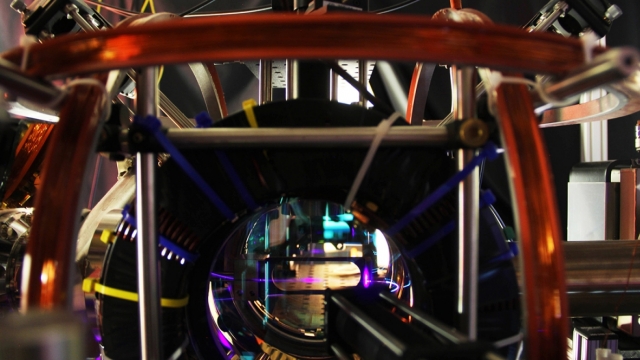Aug 24 2015
Experimental quantum physics often resides in the coldest regimes found in the universe, where the lack of large thermal disturbances allows quantum effects to flourish. A key ingredient to these experiments is being able to measure just how cold the system of interest is.
Laboratories that produce ultracold gas clouds have a simple and reliable method to do this: take pictures! The temperature of a gas depends on the range of velocities among the particles, namely the size of the difference between the slowest- and the fastest-moving particles. If all the atoms evolve for the same amount of time, the velocity distribution gets imprinted in the position of the atoms. This is analogous to a marathon where all the runners start together so you cannot immediately tell whom is the fastest, but after some time you can discern by eye whom is faster or slower based on their location.
 Photo of vacuum chamber in lab that houses experiment. The glowing purple and blue light is scattering from the optical nanofiber, making it visible through large glass viewport. Image credit: E. Edwards/JQI
Photo of vacuum chamber in lab that houses experiment. The glowing purple and blue light is scattering from the optical nanofiber, making it visible through large glass viewport. Image credit: E. Edwards/JQI
In some experiments, however, the cloud is so well-hidden that snapshots are near impossible. A new technique developed by JQI researchers and published in Physical Review A as an Editor’s Suggestion, circumvents this issue by inserting an optical nanofiber (ONF) into a cold atomic cloud.
ONFs are like the normal optical fibers that form the global telecommunications network, except that they are much thinner – only a few hundred nanometers in diameter (about 200th the width of a human hair). This small size allows ONFs to be integrated with another, much larger system without disturbing it. Moreover, light can actually couple into the ONF through its so-called evanescent field. When an electromagnetic field, like laser light, cannot propagate from one media (e.g. air or glass) to another it does not just reflect or disappear at the interface. The field must be continuous and it gradually turns off as it flows into the new media--this spatially decaying field is called the evanescent field. Evanescent fields occur in nature, such as when an ocean a wave breaks into the shore and it slowly propagates just so far into the sand. Notably, due to its narrow size, light traveling down an ONF has significant fraction of its energy residing outside the fiber in the form of an evanescent field. Additionally, the laws of physics do not forbid the reverse process from happening, so light that originates outside the ONF can couple back into and propagate along the ONF.
In this experiment, laser-cooled atoms slowly move around the ONF and “blink” randomly as they absorb and reemit photons from a laser. The probability of such a photon coupling into the ONF depends directly on the amplitude of the evanescent field, and hence the position of the atom relative to the fiber. Once a photon enters the ONF, it travels down the optical fiber and is recorded with sensitive single-photon detector as a “click.” Tallying up how many times two clicks occur in different time windows gives the authors a picture of how the atoms move near the ONF. The width of the resulting signal is a measure of the average amount of time the atoms interact with the ONF, so that narrower (wider) signals correspond to faster (slower) atoms. Using these times, the authors were able to calculate the temperature of the cloud. When they compared it to the well-known method of taking pictures, they found good agreement.
This technique could be applied to systems where access for traditional imaging systems is limited or even impossible, such as in some types of hybrid quantum systems. One example would be experiments that seek to trap a cloud of rubidium atoms near a superconducting device, all housed within a dilution refrigerator. Operation of the dilution refrigerator requires careful shielding of optical and thermal radiation, preventing the use of the standard imaging temperature measurement. Additionally, other types of nanophotonic systems that use evanescent waves to link to atoms may also benefit from this type of thermometry.
This research summary was written by author and former JQI graduate student J. Grover.